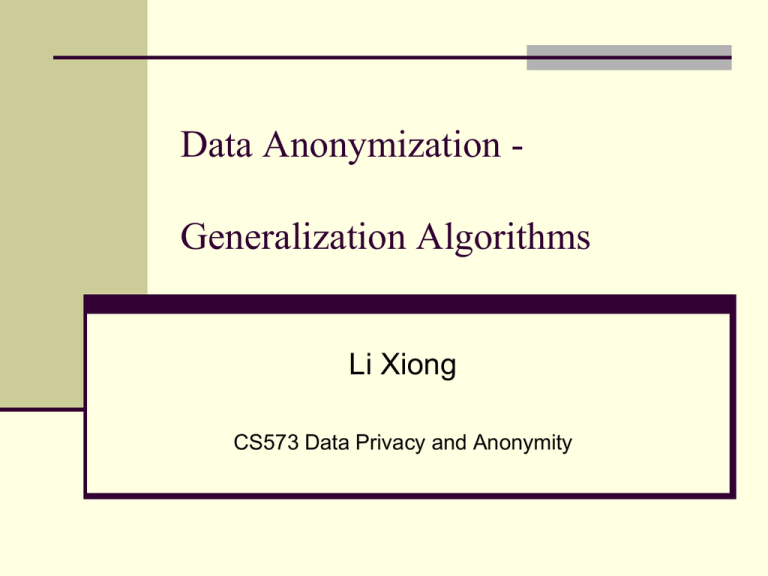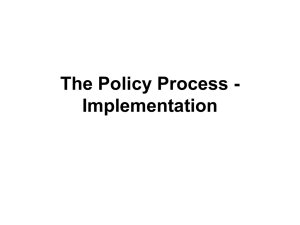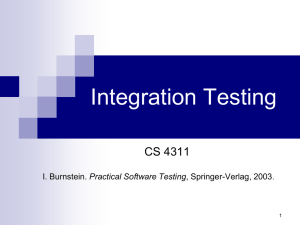
Data Anonymization Generalization Algorithms
Li Xiong
CS573 Data Privacy and Anonymity
Generalization and Suppression
• Generalization
Z2 = {410**}
Z1 = {4107*. 4109*}
Suppression
Replace the value with a less
specific but semantically
consistent value
Do not release a
value at all
Z0 = {41075, 41076, 41095, 41099}
#
S1 = {Person}
S0 = {Male, Female}
Zip
Age
Nationality
Condition
1
41076
< 40
*
Heart Disease
2
48202
< 40
*
Heart Disease
3
41076
< 40
*
Cancer
4
48202
< 40
*
Cancer
Complexity
Search Space:
• Number of generalizations =
(Max level of generalization for attribute i + 1)
attrib i
If we allow generalization to a different level for each value of an attribute:
• Number of generalizations =
attrib i
3
#tuples
(Max level of generalization for attribute i + 1)
Hardness result
Given some data set R and a QI Q, does R
satisfy k-anonymity over Q?
Easy to tell in polynomial time, NP!
Finding an optimal anonymization is not easy
NP-hard: reduction from k-dimensional perfect
matching
A polynomial solution implies P = NP
A. Meyerson and R. Williams. On the complexity of optimal k-anonymity. In PODS’04.
Taxonomy of Generalization
Algorithms
Top-down specialization vs. bottom-up
generalization
Global (single dimensional) vs. local (multidimensional)
Complete (optimal) vs. greedy (approximate)
Hierarchy-based (user defined) vs. partitionbased (automatic)
K. LeFerve, D. J. DeWitt, and R. Ramakrishnan. Incognito: Efficient Full-Domain K-Anonymity. In SIGMOD 05
Generalization algorithms
Early systems
µ-Argus, Hundpool, 1996 - Global, bottom-up, greedy
Datafly, Sweeney, 1997 - Global, bottom-up, greedy
k-anonymity algorithms
AllMin, Samarati, 2001 - Global, bottom-up, complete, impractical
MinGen, Sweeney, 2002 - Global, bottom-up, complete, impractical
Bottom-up generalization, Wang, 2004 – Global, bottom-up, greedy
TDS (Top-Down Specialization), Fung, 2005 - Global, top-down, greedy
K-OPTIMIZE, Bayardo, 2005 – Global, top-down, partition-based, complete
Incognito, LeFevre, 2005 – Global, bottom-up, hierarchy-based, complete
Mondrian, LeFevre, 2006 – Local, top-down, partition-based, greedy
µ-Argus
Hundpool and Willenborg, 1996
Greedy approach
Global generalization with tuple suppression
Not guaranteeing k-anonymity
µ-Argus
µ-Argus algorithm
µ-Argus
Problems With µ-Argus
1. Only 2- and 3- combinations are examined, there may exist 4
combinations that are unique – may not always satisfy k-anonymity
2. Enforce generalization at the attribute level (global) – may over
generalize
The Datafly System
Sweeney, 1997
Greedy approach
Global generalization with tuple suppression
Datafly Algorithm
Core Datafly Algorithm
Datafly
MGT resulting from Datafly, k=2, QI={Race, Birthdate, Gender, ZIP}
Problems With Datafly
1. Generalizing all values associated with an attribute (global)
2. Suppressing all values within a tuple (global)
3. Selecting the attribute with the greatest number of distinct values
as the one to generalize first – computationally efficient but may
over generalize
Generalization algorithms
Early systems
µ-Argus, Hundpool, 1996 - Global, bottom-up, greedy
Datafly, Sweeney, 1997 - Global, bottom-up, greedy
k-anonymity algorithms
AllMin, Samarati, 2001 - Global, bottom-up, complete, impractical
MinGen, Sweeney, 2002 - Global, bottom-up, complete, impractical
Bottom-up generalization, Wang, 2004 – Global, bottom-up, greedy
TDS (Top-Down Specialization), Fung, 2005 - Global, top-down, greedy
K-OPTIMIZE, Bayardo, 2005 – Global, top-down, partition-based, complete
Incognito, LeFevre, 2005 – Global, bottom-up, hierarchy-based, complete
Mondrian, LeFevre, 2006 – Local, top-down, partition-based, greedy
K-OPTIMIZE
Practical solution to guarantee optimality
Main techniques
4/13/2015
Framing the problem into a set-enumeration
search problem
Tree-search strategy with cost-based pruning
and dynamic search rearrangement
Data management strategies
16
Anonymization Strategies
Local suppression
Delete individual attribute values
E.g. <Age=50, Gender=M, State=CA>
Global attribute generalization
Replace specific values with more general
ones for an attribute
Numeric data: partitioning of the attribute
domain into intervals. E.g. Age={[1-10],...,[91100]}
Categorical data: generalization hierarchy
supplied by users. E.g. Gender = [M or F]
4/13/2015
17
K-Anonymization with Suppression
K-anonymization with
suppression
Global attribute
generalization with local
suppression of outlier
tuples.
Terminologies
4/13/2015
Dataset: D
Anonymization: {a1, …,
a m}
Equivalent classes: E
18
a1
E{
v1,1
…
v1,n
am
…
v1,m
vn,m
Finding Optimal Anonymization
Optimal anonymization determined by a
cost metric
Cost metrics
Discernibility metric: penalty for nonsuppressed tuples and suppressed tuples
Classification metric
4/13/2015
19
Modeling Anonymizations
Assume a total order over the set of all attribute
domain
Set representation for anonymization
E.g. Age: <[10-29], [30-49]>, Gender: <[M or F]>, Marital
Status: <[Married], [Widowed or Divorced], [Never Married]>
{1, 2, 4, 6, 7, 9} -> {2, 7, 9}
Power set representation for entire anonymization
space
4/13/2015
Power set of {2, 3, 5, 7, 8, 9} - order of 2n!
{} – most general anonymization
{2,3,5,7,8,9} – most specific anonymization
20
Optimal Anonymization Problem
Goal
Find the best anonymization
in the powerset with lowest
cost
Algorithm
set enumeration search
through tree expansion size 2n
Top-down depth first search
Heuristics
Cost-based pruning
Dynamic tree rearrangement
4/13/2015
21
Set enumeration tree over
powerset of {1,2,3,4}
Node Pruning through Cost Bounding
Intuitive idea
prune a node H if none of its
descendents can be optimal
Cost lower-bound of
H
subtree of H
22
Cost of suppressed tuples
bounded by H
Cost of non-suppressed
tuples bounded by A
A
4/13/2015
Useless Value Pruning
Intuitive idea
Prune useless values
that have no hope of
improving cost
Useless values
4/13/2015
Only split
equivalence classes
into suppressed
equivalence classes
(size < k)
23
Tree Rearrangement
Intuitive idea
Dynamically reorder
tree to increase
pruning opportunities
Heuristics
4/13/2015
sort the values
based on the
number of
equivalence classes
induced
24
Experiments
Adult census dataset
30k records and 9 attributes
Fine: powerset of size 2160
Evaluations of performance and optimal cost
Comparison with greedy/stochastic method
4/13/2015
2-phase greedy generalization/specialization
Repeated process
25
Results – Comparison
None of the other optimal algorithms can handle the census data
Greedy approaches, while executing quickly, produce highly sub-
optimal anonymizations
Comparison with 2-phase method (greedy + stochastic)
26
4/13/2015
Comments
Interesting things to think about
4/13/2015
Domains without hierarchy or total order
restrictions
Other cost metrics
Global generalization vs. local generalization
27
Generalization algorithms
Early systems
µ-Argus, Hundpool, 1996 - Global, bottom-up, greedy
Datafly, Sweeney, 1997 - Global, bottom-up, greedy
k-anonymity algorithms
AllMin, Samarati, 2001 - Global, bottom-up, complete, impractical
MinGen, Sweeney, 2002 - Global, bottom-up, complete, impractical
Bottom-up generalization, Wang, 2004 – Global, bottom-up, greedy
TDS (Top-Down Specialization), Fung, 2005 - Global, top-down, greedy
K-OPTIMIZE, Bayardo, 2005 – Global, top-down, partition-based, complete
Incognito, LeFevre, 2005 – Global, bottom-up, hierarchy-based, complete
Mondrian, LeFevre, 2006 – Local, top-down, partition-based, greedy
Mondrian
Top-down partitioning
Greedy
Local (multidimensional) – tuple/cell level
Global Recoding
Mapping domains of quasi-identifiers to
generalized or altered values using a single
function
Notation
Dx is the domain of attribute Xi in table T
Single Dimensional
φi : Dxi D’ for each attribute Xi of the quasiid
φi applied to values of Xi in tuple of T
Local Recoding
Multi-Dimensional
Recode domain of value vectors from a set of
quasi-identifier attributes
φ : Dx1 x … x Dxn D’
φ applied to vector of quasi-identifier attributes
in each tuple in T
Partitioning
Single Dimensional
For each Xi, define non-overlapping single
dimensional intervals that covers Dxi
Use φi to map x ε Dx to a summary stat
Strict Multi-Dimensional
Define non-overlapping multi-dimensional
intervals that covers Dx1… Dxd
Use φ to map (xx1…xxd) ε Dx1…Dxd to a
summary stat for its region
Global Recoding Example
k=2
Quasi Identifiers
Age, Sex, Zipcode
Single Dimensional
Partitions
Age : {[25-28]}
Sex: {Male, Female}
Zip : {[53710-53711], 53712}
Multi-Dimensional
Partitions
{Age: [25-26],Sex: Male, Zip: 53711}
{Age: [25-27],Sex: Female, Zip: 53712}
{Age: [27-28],Sex: Male, Zip: [53710-53711]}
Global Recoding Example 2
k=2
Quasi Identifiers
Age, Zipcode
Patient Data
Single Dimensional
Multi-Dimensional
Greedy Partitioning Algorithm
Problem
Need an algorithm to find multi-dimensional
partitions
Optimal k-anonymous strict multi-dimensional
partitioning is NP-hard
Solution
Use a greedy algorithm
Based on k-d trees
Complexity O(nlogn)
Greedy Partitioning Algorithm
Algorithm Example
k=2
Dimension determined heuristically
Quasi-identifiers
Zipcode
Age
Patient Data
Anonymized Data
Algorithm Example
Iteration # 1 (full table)
partition
`
dim = Zipcode
fs
splitVal = 53711
LHS
RHS
Algorithm Example
continued
Iteration # 2 (LHS from iteration # 1)
partition
`
dim = Age
fs
splitVal = 26
LHS
RHS
Algorithm Example
continued
Iteration # 3 (LHS from iteration # 2)
partition
`
No Allowable Cut
`
Summary: Age = [25-26]
Zip= [53711]
Iteration # 4 (RHS from iteration # 2)
partition
`
No Allowable Cut
Summary: Age = [27-28] Zip= [53710 - 53711]
Algorithm Example
continued
Iteration # 5 (RHS from iteration # 1)
partition
`
No Allowable Cut
`
Summary: Age = [25-27]
Zip= [53712]
Experiment
Adult dataset
Data quality metric (cost metric)
Discernability Metric (CDM)
CDM = ΣEquivalentClasses E |E|2
Assign a penalty to each tuple
Normalized Avg. Eqiv. Class Size Metric (CAVG)
CAVG = (total_records/total_equiv_classes)/k
Comparison results
Full-domain method: Incognito
Single-dimensional method: K-OPTIMIZE
Data partitioning comparison
Mondrian









